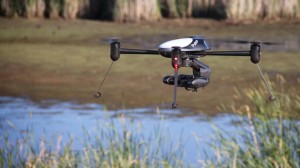 As drones continue to take flight across an array of industries, more and more farmers are seeing new possibilities in the nascent technology that could equal larger-than-ever crop yields.
As drones continue to take flight across an array of industries, more and more farmers are seeing new possibilities in the nascent technology that could equal larger-than-ever crop yields.
The latest state to see the “wow” factor of UAV-driven agriculture is North Dakota, where farmers were given a chance to see drones in action and learn more at the Big Iron Farm Show Sept. 9-11.
Grand Forks Herald writer Jonathan Knutson points out:
“The hope is farmers and ranchers will be able to use images taken from drones to run their operations more efficiently and profitably. Possibilities include drone-supplied images of pastures and feedlots that indicate whether any of the animals are sick and aerial images of growing crops that indicate whether the crops would benefit from chemical application.”
The importance of drone use lurks in the data it can gather for farmers. Conference speaker Chris Poulson stated:
“[The UAV] is a tool in the tool box. It’s the data that’s important. We could talk until we’re blue in the face about this platform versus that platform. But pick one that you know how to operate, to fly, that’s getting the data you want. It’s how you analyze that data, or how the company you’re partnering with analyzes the data.”
North Dakota has already made a name in the drone tech sector by becoming one of the few states to host a UAS Test Site sanctioned by the FAA.
Some North Dakotans worry that drone flights could be too intrusive. The exponential growth of drones sales worries regulators in North Dakota as agricultural UAVs take flight over the same farm airspace occupied by aerial crop sprayers.
The state’s Agricultural Aviation Association issued a request that farmers statewide notify aerial sprayers of the location of any UAV flights over their farms.
Col. Robert Becklund, director of the Northern Plains UAS Test Site, told the Bismarck Tribune that, with 90 percent of the hundreds of projected drone buyers using their UAVs for farming, the issue could become volatile if not handled properly.
“If someone buys one of these and flies it themself without knowledge of flight rules and right-of-way rules and they’re out of visual line of sight, they can’t see an ag sprayer. It has potential to be a problem. There’s a little grayness out there in the rules. It needs to be developed.”
Aerial sprayers also recommend that drones be painted with a highly visible color or be marked with a strobe light.
The use of drones in agriculture has sprouted a new industry and fresher innovation as UAV companies develop technology that allows farmers to monitor irrigation lines and monitor crop health.
Not only will ag drones help farmers expand their yields but the growth in UAVs down on the farm is expected to generate a bumper crop in profits for drone companies. As reported in DRONELIFE:
The Association for Unmanned Vehicle Systems International or AUVSI projects unmanned aerial vehicles or UAVs could be responsible for 100,000 new jobs by 2025. More than 80 percent of those could be in agriculture (emphasis added).
Jason is a longstanding contributor to DroneLife with an avid interest in all things tech. He focuses on anti-drone technologies and the public safety sector; police, fire, and search and rescue.
Beginning his career as a journalist in 1996, Jason has since written and edited thousands of engaging news articles, blog posts, press releases and online content.
Email Jason
TWITTER:@JasonPReagan
Subscribe to DroneLife here.







Leave a Reply